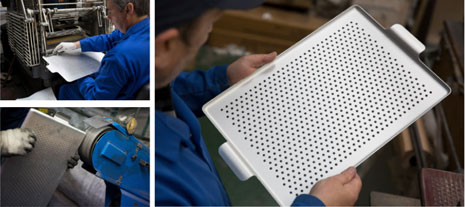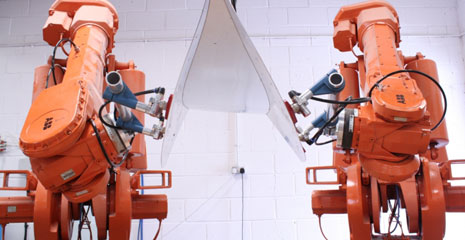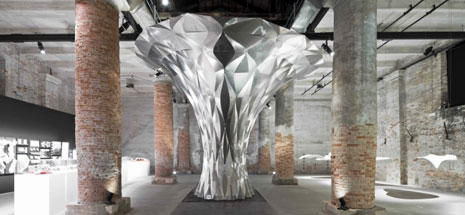
It’s the London Design Festival this week with literally hundreds of events taking place across the capital from exhibitions and talks to bike design tours and the opportunity to sneak inside designer’s workshops.
As the V&A is the hub of the festival that’s where I headed first yesterday. However, I wasn’t just interested in the various exhibits (of which I liked the Moleskine Sketch Relay very much) but also for a series of talks organised by Big Potatoes, The London Manifesto for Innovation.
Consisting of four one-hour sessions throughout the day ‘Making It In London‘ brought together a range of speakers to discuss and debate various themes around design and manufacturing in the UK’s capital.
I attended session three – London the Creative Workshop of the World? It was a very enjoyable hour, not least of all because of a call from one of the speakers to assassinate Lord Alan Sugar.
However, as this call only came right at the end of the hour during the panel discussion, I’ll deal with what the talks were actually about first.
Now I know that London is very strong on the creative side with many design consultancies and companies working within its boundaries, but I really didn’t think that very much was still physically made in London.
Of course, back in the day, London was an industrial powerhouse with ship-building in Deptford, engineering in Clerkenwell, weaving in Spitalfields, automotive in Dagehnam and aerospace in Hackney Marshes, to name but a few. Today I can only think of Brompton Bikes (which Al and I visited a while back and wrote about) that still design and manufacture in London.
However, according to the speaker Mark Brearley, an architect who amongst other activities has advised the Mayor’s Office about urbanism and public spaces, claims that London is surprisingly industrial. As part of an exercise to map the city, he discovered that of the 4.2 million jobs, 11 per cent of them happen to be in industrial areas.
Brearley was intrigued by this so as a hobby decided to make a list of these manufacturing companies. He is currently at 1,800 with the list boasting paint manufacturers, metal spinners, foundries, furniture manufacturers, printers, gun makers etc.
In fact, during this quest to find London manufacturers he has become a proprietor of Kaymet, an ailing company in Burnsey that has been making aluminium trays, trolleys and hotplates since 1947.

“This is just one example of the sparks I see in looking across London. In fact, today we are launching our stand at Design Junction as part of the London Design Festival and it’s the first time that Kaymet will be shown at a design focussed event to try and get the products out to a wider and different audience,” says Brearley.
Then the first of two speakers selected to prove how design and manufacturing is very much alive and kicking in London, was Tobi Schneider, CEO of Bouncepad.
Based in Camden, Scheider introduced his company as “making physical stuff for a digital world in the middle of London.”
The ‘physical stuff’ is tablet/iPad enclosures or kiosks with all the design, engineering, assembling and shipping taking place at Bouncepad’s Camden HQ.

The company has grown since Schneider set it up in January 2011 and its products can now be seen in a variety of places such as the Guardian’s digital cafe (above), V&A’s galleries and in each pod of the London Eye. “There is even a company that builds cow wash machines that has implemented Bouncepads. We still haven’t got pictures back of how they actually use them,” smiles Schneider.
Next was Greg Epps who founded Robofold, a company in Herne Hill, south London, that uses robots to fold sheet metal (predominately 1.5mm aluminium). He came up with the idea of folding metal at the age of 17 and since then he has spent a long 15 year journey trying to industrialise the process.
“The fact that this could be a viable manufacturing process started with me folding bits of paper and then realising I could do the same thing with different pieces of metal. When I started no one really thought it was possible but I managed to find a process to fold metal that didn’t require thousands of pounds worth of tooling,” he explains.

Through various grants and funding this Imperial College graduate has been able to research finite element modelling, develop software to control the machines and invest in ABB robots.
The result is that Robofold’s unique technology can be easily manipulated to produce a design with variable folds and curves, completely differing from standard robots doing a single function repetitively and alone.
“I think our technology has a lot of parallels with 3D printing. It’s a similar idea in that if you design something in software a 3D printing machine will create that from plastic, for example, and this idea really is changing the way we design.
“It’s making it possible to go very quickly from an idea to the actual production part and the big question for these types of technologies is how will they be used and will they really be used to replace existing processes?”

Above is an example that demonstrates what can be achieved with this process. For the Venice Bienalle last year, Robofold created a sculpture (11 metres in length x 6 metres wide) for Zaha Hadid Architects that consisted of 488 unique panels. However, as the panels are self similar, the instruction set is the same which means the manufacturing process was relatively quick.
It was during the panel discussion at the end, amongst various debate and banter around how to ensure London becomes even more of a creative and manufacturing hub, when Schneider called for the assassination of Lord Alan Sugar. He said that through his TV programme The Apprentice Lord Sugar is actually propagating a kind of capitalism that is completely opposite to how good companies work.
For example, with his own company, although it is very small, there is a scheme in place where the whole workforce is actually participating in the success of the company and everyone has a stake in actually making better products and selling more.
Considering the success Bouncepad has experienced in just two and a half years, perhaps this ‘flat structure’ is one to emulate if companies want to succeed in the modern economy.






